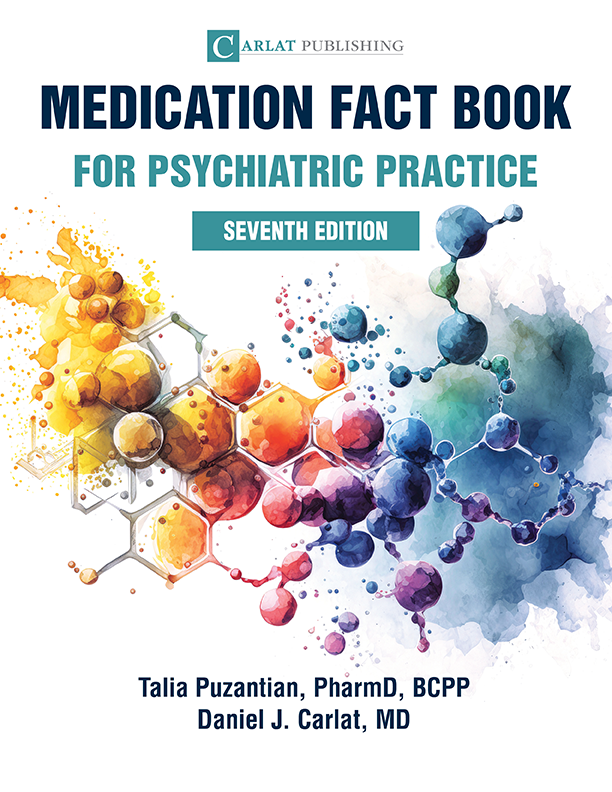Why valproate is the #1 contraindicated med in pregnancy, and what are the other close contenders.
Publication Date: 5/22/2023
Duration: 12 mins, 00 seconds
Transcript:
There’s one med you should never use in a pregnant woman, and new guidelines suggest avoiding it in women of reproductive age altogether.
CHRIS AIKEN: Welcome to the Carlat Psychiatry Podcast, keeping psychiatry honest since 2003. I’m Chris Aiken, the journal’s editor and the coauthor of the textbook Prescribing Psychotropics.
KELLIE NEWSOME: And I’m Kellie Newsome, a psychiatric NP and a dedicated reader of every issue.
Before we release the 9th commandment, let’s recap the first 8:
I.Do not worsen mental illness with psychiatric medications, like don’t use antidepressants in rapid cycling bipolar disorder, or psychostimulants in psychosis.
II.Avoid stopping meds abruptly, particularly benzodiazepines and serotonergics.
III.Prevent lithium toxicity by checking interactions, age, and renal function.
IV.Stop lamotrigine if any rash develops in the first 3 months.
V.Do not combine benzodiazepines and opioids in patients at high risk for overdose death.
VI.Honor thy MAOI interactions.
VII.Controlled substances shall be controlled, by you.
VIII.Avoid unwise medication combinations, like benzos and stimulants, or stimulants and antipsychotics. And #9
IX.Avoid valproate, Depakote, in pregnancy.
CHRIS AIKEN: Valproate is the only psychiatric medication with a near absolute contraindication in pregnancy. The risks are clear:
- Congenital malformations, including spina bifida, facial malformations, neural tube defects, cleft palate, hypospadias (a defect at the opening of the penis), atrial septal defect, and polydactyly (more than 10 fingers).
- A 10 point drop in IQ
- Delayed motor skills
- Higher rates of ADHD and autism
Sure, lots of meds have been associated here and there with risks like those, but what makes valproate stand out is the sheer frequency. 1 in 10 exposed babies will have a malformation, and nearly half will have some sort of neurodevelopmental delay including lower IQ. Shortly after the medication entered widespread use in the late 1970’s, this valproate fetal syndrome was described, and have since been confirmed in large epidemiologic studies.
KELLIE NEWSOME: This commandment is an absolute. No negotiations. And some draw an even harsher line. The British Association for Psychopharmacology recommends avoiding valproate entirely in girls and women of childbearing age. The FDA issued a similar warning in 2013, advising that valproate should not be used for any condition in women of childbearing age unless other reasonable options were exhausted.
But it doesn’t look like many have taken heed. In a 2018 survey of 4,000 British patients with mood disorders, 1 in 4 women under the age of 50 were still taking valproate.
Let’s pause for a preview of the CME question for this episode. To earn CME for the podcast, click on the link in the show notes.
1. Which antidepressant has the best overall safety data for pregnancy and breastfeeding?
A. Clomipramine
B. Escitalopram
C. Vortioxetine
D. Sertraline
CHRIS AIKEN: If you do use valproate in women who could become pregnant, make sure they understand the risk and that they take folic acid with it. This reduces the risk of problems should any pregnancy occur. Valproate depletes folic acid, and there is a small controlled trial where adding folic acid improved valproate’s benefits in acute mania. Some guidelines recommend a pregnancy test before starting valproate, and all emphasize adherence to birth control.
If your patient does become pregnant on valproate, switch. Lithium, antipsychotics, and lamotrigine all have lower risks of teratogenicity than valproate and can be substituted if needed during a pregnancy. Carbamazepine is a little riskier, less than valproate, but more than lithium. Lamotrigine has the highest level of safety data in bipolar disorder, but its main benefits are for prevention not active treatment.
No one knows for sure how to taper psych meds – we study how to start them, but not how to stop them. But here’s some guidance. If your patient is not pregnant, and you want to get them off valproate to avoid these risks, taper over at least 4 weeks. If they are pregnant and psychiatrically stable, taper over 2 weeks. That’s right, don’t stop abruptly. Withdrawal effects can be just as problematic, according to a 2019 expert consensus paper. If they are pregnant and in an active mania, you can taper faster – and switch – as here the valproate is likely not even working.
KELLIE NEWSOME: Valproate is the riskiest med in pregnancy, but it is not as risky for breastfeeding. In pregnancy, we worry about organ malformation. In breastfeeding, the organs have already developed and the concern is that they infant will get toxic effects of the accumulating medication, such as sedation. Dial back to our December 19, 2022 episode for a refresher on breastfeeding and psychiatric medications.
CHRIS AIKEN: Valproate is not the only medication to avoid in pregnancy. Our December 12, 2022 episode reviewed the subject in more detail, and here are the others to avoid:
- Paroxetine (Paxil), lithium, carbamazepine, tricyclic antidepressants (particularly clomipramine), benzodiazepines, and stimulants like Ritalin and Adderall.
Two that stand out there are paroxetine and the benzodiazepines. Paroxetine is the only SSRI with a category D warning, which it earned for cardiac defects. Some would debate whether it really deserves that ignominy, I’d prefer to stay out of those debates, especially in front of a jury. With so many other antidepressants to choose from, there’s little reason to select paroxetine in women of reproductive age, especially considering it’s other problems like a higher risk of serotonin withdrawal syndrome.
KELLIE NEWSOME: Sertraline is the safest antidepressant in both pregnancy and breastfeeding. Escitalopram, fluoxetine, and bupropion are also safe in pregnancy, but they are not as safe as sertraline in breastfeeding.
CHRIS AIKEN: The benzodiazepines are particularly risky in the third trimester where they can cause benzo withdrawal symptoms, floppy infant syndrome, and respiratory and feeding difficulties. The problem with benzos – and with sleep meds – is in justifying their medical necessity. With the possible exception of panic disorder, long-term benzodiazepine use is not a well-supported treatment for psychiatric disorders. Its indication is for acute treatment of anxiety, but for that you’d probably try a less risk intervention like psychotherapy in a pregnant woman. But even as we avoid starting a benzodiazepine in pregnancy, we’ll likely see women who become pregnant who are already on a long-term benzo. Here we’ve got the withdrawal syndrome to deal with. In an ideal world, we’d taper the medication off – over 4-6 weeks – while starting CBT. In an even more ideal world, we’d get Michael Otto to conduct the CBT, using the model he developed for benzo withdrawal, which emphasizes fears about withdrawal and exercises to manage the physical sensations like deep breathing and progressive muscle relaxation, much as they do for panic disorder. If only we lived in such a world.
KELLIE NEWSOME: Psychotherapy, brisk walking, Mediterranean style diet, sleep hygiene… all of these can help your pregnant patients keep some version of sanity while minimizing their peripartum med list. Add to that TMS or light therapy for depression, and ECT for severe depression – all of these devices are safe and effective in pregnant women.
And now for the study of the day….
“Alcohol and lactation: Developmental deficits in a mouse model” by Roberto Perez and colleagues from Frontiers in Neuroscience.
CHRIS AIKEN: Last year, the CDC made it clear: There is no safe amount of alcohol during pregnancy. But what about in breastfeeding? Little is known about the risks there, and a controlled human study would not be ethical, so we turn to this 2023 study which tested alcohol in a controlled study of breastfeeding mice. The results offer up a warning: Baby mice exposed to alcohol through breast milk had lower body weights, lower brain weights, and a thinner cerebral cortex. They grew up to be hyperactive risk takers, and had difficulty managing stress.
Controlled studies in humans are non-existent, but the uncontrolled data points the same way. Alcohol exposure during breastfeeding has been linked to lower IQ, lower body mass, and various behavioral problems.
Alcohol in human breast milk mirrors the amount in the blood stream, peaks 30-60 minutes after a drink, and is still detectable for up to 3 hours after a drink.
KELLIE NEWSOME: Get more research updates like these through Dr. Aiken’s LinkedIn or Twitter feeds @ChrisAikenMD. Do you know of lines that should not be crossed in psychopharmacology? Send us your ideas for the 10 commandments to asktheeditor@thecarlatreport.com.
Subscribe to our online journal and get $30 off your first year’s subscription with the promo code PODCAST. The Carlat Report is one of the few CME publications that depends entirely on subscribers. Thank you for helping us stay free of commercial support.
__________
The Carlat CME Institute is accredited by the ACCME to provide continuing medical education for physicians. Carlat CME Institute maintains responsibility for this program and its content. Carlat CME Institute designates this enduring material educational activity for a maximum of one quarter (.25) AMA PRA Category 1 CreditsTM. Physicians or psychologists should claim credit commensurate only with the extent of their participation in the activity.


_-The-Breakthrough-Antipsychotic-That-Could-Change-Everything.jpg?1729528747)



